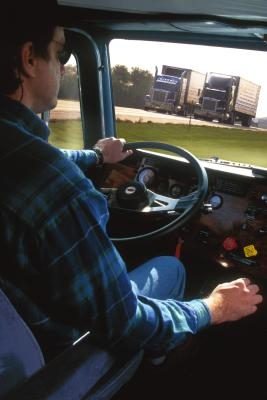
Shifting a Freightliner 10-speed manual transmission takes skill, coordination, awareness of engine rpm and practice. The skills required include knowing when to upshift and downshift, dictated by load and grade conditions. Coordination is needed to smoothly balance the operation of the clutch pedal, accelerator pedal, shift lever and shift button during a shift. The driver must also be aware of the sound that the engine makes when it is time to upshift or downshift. And of course, practice makes perfect.
Start the Freightliner truck's engine according to the starting procedures outlined in the truck manufacturer's owner's manual. Allow the air pressure in the truck's air compressor to build to between 90 and 120 psi. Air pressure is indicated by the air pressure gauge on the Freightliner's dashboard. Push the brake pedal with the right foot. Release the parking brake by pushing in both the tractor parking brake and trailer parking brake knobs.
Depress the clutch all the way to the floor using your left foot. Move the shift lever into first gear by moving the shift lever to the left as far as it will go in the neutral gate and then to the rear into the left shift gate. Slowly release the clutch pedal until the clutch has engaged when the pedal is at the top of its travel. Push the accelerator gradually with the right foot.
Accelerate the Freightliner until the truck needs to be shifted from first to second gear. The shift point will be dictated by the type of engine installed in the Freightliner. Refer to the engine manufacturer's operating instructions for optimal engine operating rpm ranges. When the top rpm of the optimal engine operating range has been reached, move the shift button forward and break the torque between the engine and transmission by releasing accelerator pressure. The transmission will automatically fall into second gear when the engine rpm synchronizes with the road speed of the truck. This is known as button shifting. As soon as second gear engages, push the gas pedal again to keep accelerating. When the engine rpm reaches the top of the optimal operating range, it's time to shift again.
Move the shift button back to the rear position before shifting into the next gear. Immediately break the torque on the powertrain by releasing the pressure on the accelerator with the right foot while slightly depressing the clutch with the left foot. Use a double-clutching technique by moving the shift lever into neutral and releasing the clutch pedal. When engine rpm reaches the lower end of the optimal engine operating range, depress the clutch slightly with the left foot and move the shift lever to engage third gear. Release the clutch and apply the accelerator. This is known as combination button/lever shifting.
Alternate the button shift and button/lever shift until the transmission is finally in 10th gear. Use the same techniques for downshifting, remembering to keep the button in the rearmost position on the shift knob whenever you need to shift to an odd-numbered gear and in the forward position for an even-numbered gear.